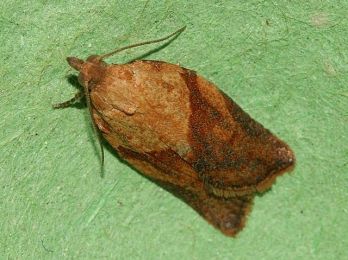Light brown apple moth
The light brown apple moth (Epiphyas postvittana) is a major pest species with a wide host range.
Background
In both appearance and behaviour, the light brown apple moth (LBAM) is similar to other species in the family Tortricidae. It is a native leafroller that attacks:
- grapevines
- pome fruit and citrus
- vegetable crops
- broadleaf weeds
- some pasture species
- ornamental plants.
Impacts
The larvae cause significant damage to foliage and fruit. Early instars feed on tissue beneath the upper epidermis (surface layer) of leaves, while protected underneath.
Larger larvae migrate from these positions to construct feeding niches between leaves or fruit, in the developing bud, or on a single leaf where the leaf roll develops. The late-stage larvae feed on all leaf tissue except main veins.
Young larva may enter the interior of an apple or pear through the calyx, or beneath the stem of a citrus fruit. Excreta are usually ejected on to the outside of the fruit.
Beneficials
LBAM eggs are destroyed by tiny parasitic Trichogramma wasps. Natural enemies of the larvae include:
- parasitic wasps Dolichogenidea arisanus and Xanthopimpla spp.
- parasitic flies Goniozus spp. and Zosteromyia spp.
- predatory bug Ochalia shellembergii
- lacewings
- spiders
- various pathogens.
Identification
The buff-coloured moths are about 10mm long. They are seldom seen, remaining concealed under leaves during the day and becoming active towards dusk.
The female moths lay scale-like eggs in batches on the upper surfaces of leaves. These are an aqua colour and darken before hatching.
The young larvae are pale yellow and about 1mm long. The mature larvae are pale to medium green, with a darker green central stripe, growing to about 18mm. The newly formed pupa turns from green to brown.
Lifecycle
Larvae disperse by crawling or dropping on silk threads, then settling on the undersurface of a leaf. They spin a silken web there for protection while feeding.
The larvae abandon their webs after their first moult and construct a sheltered nest. These are found between the sides of a leaf or adjacent leaves, fruits, flowers, or berries within a grape-bunch.
The larvae pass through 6 development stages. If disturbed, they wriggle rapidly and move further into their shelter, or drop to the ground, or hang suspended by a silk thread.
Pupation occurs at the feeding site and the moth emerges a few weeks later.




